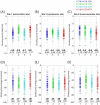Effects of chemosynthetic choline plasmalogens on gonadotropin secretion from bovine gonadotrophs
- PMID: 40484677
- PMCID: PMC12322497
- DOI: 10.1262/jrd.2025-019
Effects of chemosynthetic choline plasmalogens on gonadotropin secretion from bovine gonadotrophs
Abstract
Ethanolamine plasmalogens (EPls) and choline plasmalogens (CPls), unique glycerophospholipids may play important roles in milk production and reproduction in postpartum dairy cows. While CPls are more abundant in bovine blood, EPls are predominant in the brain. Brain EPls are the only recognized ligands of G protein-coupled receptor 61 (GPR61), a receptor that co-localizes with GnRH receptors on gonadotrophs. We hypothesized that chemosynthetic CPls stimulate gonadotropin secretion from bovine gonadotrophs, similar to the reported effects of chemosynthetic EPls. Anterior pituitary cells from healthy, post-pubertal heifers, were cultured for 3.5 days and then treated with increasing concentrations (0, 0.7, 7, 70, or 700 pM) of EPl with vinyl-ether-bonded stearic acid and ester-bonded oleic acid (C18:0-C18:1EPl) as a positive control, or CPls with vinyl-ether-bonded stearic acid and ester-bonded oleic acid (C18:0-C18:1CPl), arachidonic acid (C18:0-C20:4CPl), or docosahexaenoic acid (C18:0-C22:6CPl). After 2 h, the medium samples were harvested for FSH and LH assays. C18:0-C18:1EPl (7-700 pM) stimulated basal FSH and LH secretion (P < 0.01). None of the tested CPl concentrations stimulated LH secretion. Only 700 pM of C18:0-C18:1CPl, but not lower concentrations, stimulated FSH secretion (P < 0.05), an effect that was inhibited by a SMAD pathway inhibitor. However, both C18:0-C18:1CPl and C18:0-C20:4CPl synergized with GnRH to stimulate FSH secretion. In silico molecular-docking simulations using the deep-learning algorithm ColabFold revealed that CPls bind to the three-dimensional structural model of GPR61. In conclusion, C18:0-C20:4CPl stimulated FSH secretion exclusively in the presence of GnRH, whereas C18:0-C18:1CPl weakly stimulated FSH secretion and showed potential interaction with the GnRH signaling pathways.
Keywords: ColabFold; Drug discovery; Follicle-stimulating hormone; Gonadotropin-releasing hormone receptor; Luteinizing hormone.
Conflict of interest statement
The authors have nothing to declare.
Figures






Similar articles
-
Chemosynthetic ethanolamine plasmalogen stimulates gonadotropin secretion from bovine gonadotrophs by acting as a potential GPR61 agonist.Anim Reprod Sci. 2022 Jun;241:106992. doi: 10.1016/j.anireprosci.2022.106992. Epub 2022 May 13. Anim Reprod Sci. 2022. PMID: 35580407
-
Ethanolamine plasmalogens derived from scallops stimulate both follicle-stimulating hormone and luteinizing hormone secretion by bovine gonadotrophs.Sci Rep. 2022 Oct 6;12(1):16789. doi: 10.1038/s41598-022-20794-4. Sci Rep. 2022. PMID: 36202862 Free PMC article.
-
Ethanolamine plasmalogens derived from whale brain stimulate both follicle-stimulating hormone and luteinizing hormone secretion by bovine gonadotrophs.Anim Sci J. 2023 Jan-Dec;94(1):e13839. doi: 10.1111/asj.13839. Anim Sci J. 2023. PMID: 37247943
-
A New Bihormonal Model for the Brain Regulation of Gonadotropins in Teleosts.Neuroendocrinology. 2025;115(8):648-656. doi: 10.1159/000546403. Epub 2025 May 21. Neuroendocrinology. 2025. PMID: 40398401 Review.
-
Discovery of new receptors regulating luteinizing hormone and follicle-stimulating hormone secretion by bovine gonadotrophs to explore a new paradigm for mechanisms regulating reproduction.J Reprod Dev. 2020 Aug 20;66(4):291-297. doi: 10.1262/jrd.2020-012. Epub 2020 Apr 6. J Reprod Dev. 2020. PMID: 32249236 Free PMC article. Review.
References
-
- Pandey K, Kereilwe O, Borromeo V, Kadokawa H. Heifers express G-protein coupled receptor 61 in anterior pituitary gonadotrophs in stage-dependent manner. Anim Reprod Sci 2017; 181: 93–102. - PubMed
-
- Kereilwe O, Pandey K, Kadokawa H. Influence of brain plasmalogen changes on gonadotropin secretion from the cultured bovine anterior pituitary cells. Domest Anim Endocrinol 2018; 64: 77–83. - PubMed
-
- Braverman NE, Moser AB. Functions of plasmalogen lipids in health and disease. Biochim Biophys Acta 2012; 1822: 1442–1452. - PubMed

